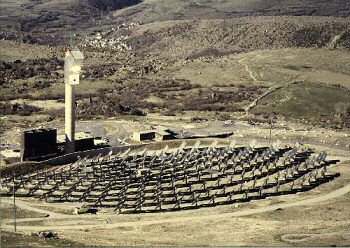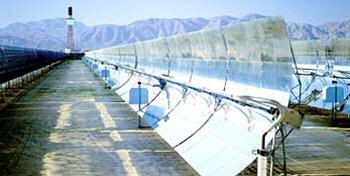thermodynamic solar energy.
Definition
Mechanical or thermodynamic solar energy concerns devices which transform solar radiation (heat) "directly" into mechanical movement which either, can be used directly or will be transformed into electricity.
Mechanical solar is a rare and very special technique. Each “solar engine” has unique, not to say unique, characteristics. It is therefore very difficult, unlike the other two uses of solar, to present an operating principle. One thing in common: the concentration of solar energy via solar concentrators (heliostats, mirrors, etc.). We will come back to these techniques in a future article.
To present this technique, we will therefore cite three practical examples: the Solar Stirling engine, the Minto Wheel and thermal solar power plants (in reality: thermodynamics would be a more adequate term) producing electricity.

All these projects and drivers are nevertheless quite marginal. A higher cost of fossil fuels could boost R&D for such solar applications.
Three examples of mechanical solar installations.
a) solar Stirling engine:
The famous hot-air engine with the heat source is the sun. For more information about her, click here
b) The wheel of Minto:
Project of an independent inventor who has never seen the light of day industrially yet the idea seems good.
Technical details and discussion, click here
c) Solar power (solar or electric): these are the most successful mechanical solar projects.
A solar thermal power plant is made up of a field of special solar collectors called heliostats which concentrate the sun's rays on a pipe in which circulates a coolant which drives a turbine which produces electricity.
The largest solar thermal power plant is called Solar Two, is located in California's electric power reaches 150 megawatts (150 000 kW!).
There 2 Examples of such plants in France: the solar plant Vignola (Corse-du-Sud) or solar power Themis (Pyrenees).
The story of Themis(Comment from Jean Jacques BEZIAN, Doctor Engineer in Energy Physics and Teacher-researcher at the Center for Energetics of the Ecole des Mines de Paris)
THEMIS solar power plant was built on the site of Targasonne, and it produced its last kilowatt hour the 30 September 1986!

The only French test of electricity production using a tower solar power plant, the THEMIS adventure took place in three stages:
- a preparatory phase from 1975 to 1979, around a mixed EDF - CNRS team;
- a construction phase, from 1979 to 1983, under the authority of EDF (the Région d'Equipement Alpes Marseille, REAM;
- an exploitation phase, from June to September 1983 1986, the Regional Group of Thermal Production (GRPT) Mediterranean.

It was during this period that three teams of experimenters, one from the Department of Studies and Research (DER) of EDF, based in Chatou, in the Paris region, a second in the premises of the Ecole Centrale, in Paris, attached to the CNRS, the last, on the site, the THEMIS Scientific Assessment Group (GEST, mixed AFME - CNRS team) analyzed the performance obtained and proposed innovative concepts for future commercial centers.
Since then, nothing (at the level of solar applications), but astrophysical measurement campaigns, and a few thousand visitors per year for this modern but immobile vestige of French hopes of acquiring a thermodynamic electro-solar sector.
More:
- laboratory site PROMES (Processes, Materials and Solar Energy) attached to the CNRS.
- Video report on the crazy and solar plants
- The solar project Desertec desert

